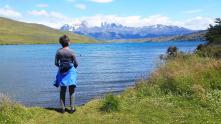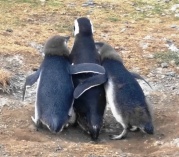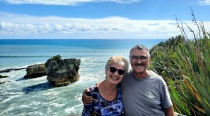Von der chilenischen Grenze bis Puerto Natales
Die Abfertigung am nächsten Tag an der chilenischen Grenze erfolgt zügig - der Zöllner ist sehr zufrieden mit unserer gründlichen Vorarbeit!
Gegen Abend erreichen wir den Nationalpark Torres del Paine, ein 242.000 Hektar großes Gebiet in den südchilenischen Anden mit einer beeindruckenden Landschaft und derzeit der am meisten gehypte Nationalpark in Chile. Täglich kommen Busladungen voll mit Backpackern hier an.
Wir verbringen 5 Tage im Park, machen jeden Tag ausgiebige Wanderungen und dürfen immer frei an den Rangerstationen übernachten mir herrlichem Blick auf die Seen und Berge!
Und wir haben echt Riesenglück mit dem Wetter, erst am letzten Tag erwischt uns der Regen - so fällt der Abschied vom Park leichter.
Unser nächstes Ziel ist Puerto Natales, eine kleine Hafenstadt am Ufer des Fjords Ultima Esperanza.
Hier erreicht uns das typisch südpatagonische Wetter mit stürmischem Wind und ständigem Wechsel zwischen Sonne und Regen.
Bei einem Besuch im historischen Museum erfahren wir viel über die Ureinwohner der Region und das Leben der europäischen Einwanderer, unter ihnen auch viele Deutsche.
--------------------------------------------------------------------
From the Chilean border to Puerto Natales
The border crossing into Chile is easy and quick, obviously we impressed the customs officer with all our vegetables cooked.
Late in the evening we arrive the National Park Torres Del Paine, with its impressive alpine landscape. Presently it is obviously hype to do trekking in the park. Dozens of buses dump hundreds of backpackers every day.
We spend 5 days in the park and as soon we are off the main trek we are almost alone, spending our nights next to ranger stations, where it is allowed to camp with a self-contained motorhome, mostly with spectacular views on mountains or lakes.
And we are super lucky with the weather, only partly cloudy with a lot of sunshine, only on our last day we are hit by the formidable Patagonian rain and wind, which makes it easier to say good bye.
Our next stop is Puerto Natales, a small harbour town on the shore of Fjords Ultima Esperanza. Our town visit is often interrupted by the typical South Patagonian weather, strong winds and a frequent change between rain and sunshine. A good opportunity to visit the historical museum, where we can learn a lot about the Native Americans before the European settlers arrived.
_____________________________________________________________
Von Puerto Natales bis Punta Arenas
Auf unserer 250 km langen Fahrstrecke nach Punta Arenas sehen wir kilometerweit keine anderen Lebewesen als Schafe und Lamas - Patagonien lebt immer noch zum größten Teil von der Schafzucht.
Punta Arenas ist die südlichste Kontinentalstadt der Welt und liegt direkt an der Magellanstraße gegenüber von Feuerland.
Unser erstes Ziel ist der Friedhof der Stadt, gerühmt als der schönste und interessanteste Chiles. Hier bestaunen wir die Mausoleen, die eher ausschauen wie Paläste, welche die Schafbarone für ihre Verstorbenen errichten ließen. Sie zeigen den verflossenen Reichtum der Gründerzeit.
Im Zentrum Punta Arenas stehen noch viele alte, elegante Häuser, die an diesen Reichtum erinnern.
In der Stadtmitte sehen wir - wie auch schon auf dem Friedhof - Spuren der Proteste der vergangenen Monate. Vor allem die Banken sind verbarrikadiert.
Von Punta Arenas aus machen wir bei schönstem Wetter einen Schiffs-Ausflug auf die Isla Magdalena. Hier leben in den Sommermonaten ca. 10.000 Magellan-Pinguine. Einige von ihnen
laufen direkt über unseren markierten Weg und beäugen uns eher neugierig als scheu. Ein unvergessliches Erlebnis!
Bei Punta Delgada setzen wir an der schmalsten Stelle über die Magellanstraße und erreichen Feuerland - Tierra del Fuego.
Der Archipel - 73.746 km² groß - besteht aus der Hauptinsel und Dutzenden vorgelagerter Inseln. Zu Chile gehört der größere Teil des Archipels, etwas mehr als 47.000 km².
---------------------------------------------------
From Puerto Natales to Punta Arenas
On our 250 km long route to Punta Arenas there is only sheep and llamas - Patagonia still lives mainly from sheep farming.
Punta Arenas is the southernmost continental city in the world and is located directly on the Magellan Strait opposite Tierra del Fuego.
Our first touristic highlight is the city's cemetery, praised as the most beautiful and interesting in Chile. We marvel at the tombstones which look more like “palaces” that the sheep barons had
built for their deceased. In the center of Punta Arenas there are still many old, elegant houses that are reminiscent of this wealth.
Downtown we can see traces of the political protests of the past few months. Mainly official buildings and banks are barricaded.
From Punta Arenas we take a boat trip to the Isla Magdalena where app. 10.000 Magellan penguins live here in the summer months. Some of them directly cross our marked path and look at us more curious
than shy. An unforgettable experience!
At Punta Delgada we cross the Magellan Strait at the narrowest point for Tierra del Fuego.
The archipelago - 73,746 km² - consists of the Main Island and dozens of offshore islands. The greater part of the archipelago belongs to Chile, just over 47,000 km².
____________________________________________________________


















































